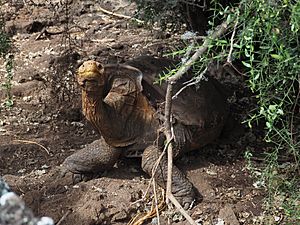Diego (tortoise) facts for kids

Diego photographed in 2009
|
|
| Species | Hood Island giant tortoise (Chelonoidis niger hoodensis) |
|---|---|
| Sex | Male |
| Hatched | 1910s Española Island, Ecuador |
| Nation from | Galápagos |
| Known for | participation in tortoise breeding program |
| Offspring | Around 900 |
| Weight | 80 kg (176 lb) |
| Height | 90 cm (2 ft 11 in) x 1.5m |
| Named after | San Diego Zoo |
Diego is a famous Hood Island giant tortoise. He is from the Galápagos Islands in Ecuador. Diego became a hero for his species. He helped save his kind from disappearing forever.
Diego was captured when he was young. He was sent to a zoo in the United States. Later, scientists discovered he was a rare Hood Island tortoise. He then joined a special breeding program. This program aimed to save his species. Diego fathered more than 900 baby tortoises. These babies were released back into the wild. Thanks to Diego and others, the tortoise population grew a lot. He is now retired and lives freely on his home island.
Diego's Early Life
Diego was likely born on Española Island. This is one of the Galápagos Islands. He hatched sometime before the 1920s.
When he was a young adult, Diego was captured. He was sent to the United States. This happened between 1928 and 1933. He was part of a group of tortoises sent to American zoos. By the late 1940s, Diego was living at the San Diego Zoo in California. At that time, no one knew exactly what type of tortoise he was.
Helping His Species Survive
The Hood Island giant tortoise (Chelonoidis niger hoodensis) faced big dangers. People hunted them for food. Also, goats brought to the island ate their food. Because of this, the species became critically endangered in the 1960s. This means they were very close to dying out.
In 1976, a special breeding program started. There were only 12 female and 3 male tortoises left on Española Island. Only two of the males could have babies. So, the program looked for other Española tortoises in zoos.
Diego had been at the San Diego Zoo for 30 years. DNA tests showed he was a Hood Island tortoise. In 1977, he moved to Santa Cruz Island in the Galápagos. There, he joined the breeding program.
The three male tortoises, including Diego, were put with different females. Their baby tortoises were released onto Española Island. This happened once or twice a year. About half of the young tortoises survived in the wild. Diego became a super dad! He fathered about 900 offspring. This was about 40% of all the babies born in the program. Another tortoise, E5, fathered most of the rest. The third male, E3, had very few babies.
Diego's Retirement
Diego stayed with the breeding program until it ended. This was in January 2020. By then, the program had helped the tortoise population grow. There were 2,000 tortoises on Española Island. This was enough for them to survive on their own.
On June 15, 2020, Diego was released. He went back to Española Island with 14 other tortoises. Scientists believe Diego could live to be 150 years old. When he was released, he weighed about 80 kilograms (176 pounds). He measured 90 centimeters (35 inches) long. He could stretch up to 1.5 meters (5 feet) tall.



